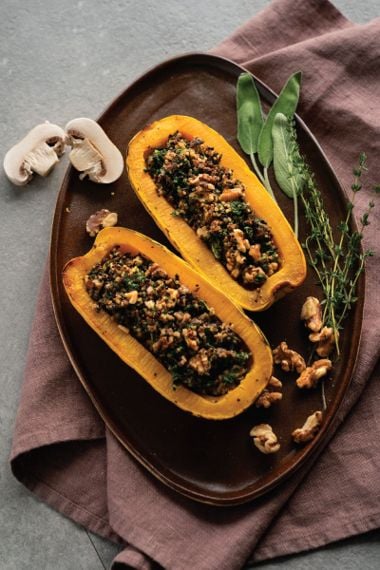
Sage is an excellent flavour companion for squash. When combined with the earthy flavours of mushroom and hearty quinoa, this filled squash makes for a deliciously satisfying meal. Great sources of dietary fibre, winter squashes like delicata and acorn are also good sources of thiamin, which aids in the transformation of ingested carbohydrates into energy.
Make ahead
You can fill and stuff the squash up to a day in advance, and refrigerate until you’re ready to serve. To heat, set the oven to 350 F (180 C) and bake on parchment-lined baking tray for 20 minutes.
Mushroom Quinoa Stuffed Roasted Squash
Ingredients
- 2 delicata or acorn squash, rind well washed
- 2 Tbsp (30 mL) fresh sage leaves, divided
- 2 tsp (10 mL) + 1 Tbsp (15 mL) extra-virgin olive oil, divided
- 3/8 tsp (1.5 mL) salt, divided
- 1/2 tsp (2 mL) freshly ground black pepper, divided
- 1/2 cup (125 mL) uncooked tricolour or white quinoa, thoroughly rinsed and drained
- 1 1/4 cups (310 mL) low-sodium vegetable stock, divided
- 1/3 cup (80 mL) finely diced peeled shallots
- 4 cups (1 L) diced white mushrooms
- 2 garlic cloves, peeled and minced
- 1 Tbsp (15 mL) chopped fresh thyme
- 2 tsp (10 mL) apple cider vinegar
- 1 1/2 cup (350 mL) finely chopped kale
- 2/3 cup (150 mL) walnut pieces
Nutrition
Per serving:
- calories331
- protein11 g
- total fat20 g
- sat. fat2 g
- total carbohydrates34 g
- sugars2 g
- fibre10 g
- sodium335 mg
Directions
01
Preheat oven to 400 F (200 C). Line baking sheet with parchment paper.
02
Cut squash in half lengthwise. Remove seeds and discard or save for another purpose. Place squash halves on parchment-lined baking sheet and brush cut side with 2 tsp (10 mL) olive oil. Sprinkle with 1/8 tsp (0.5 mL) salt and 1/4 tsp (1 mL) pepper. Rub 1 Tbsp (15 mL) sage leaves over the surface and centre of each squash half and flip halves over, cut side down, onto baking sheet. Roast for 25 to 30 minutes, or until skin of squash is easily pierced with a fork. When squash is ready, remove from oven, allow to cool, cut side down, for about 5 minutes. When cool enough to handle, flip over squash halves to cool further and set aside until you’re ready to fill. Keep oven on.
03
Meanwhile, to saucepan, add quinoa with 1 cup (250 mL) vegetable stock; cover and bring to a boil over high heat. Reduce heat to medium-low and allow quinoa to simmer, uncovered, for approximately 15 to 20 minutes, or until white endosperm or “tail” emerges from each quinoa kernel. Remove from heat, cover for 5 minutes, and then fluff with a fork. Set aside.
04
In large shallow pan, add 1 Tbsp (15 mL) olive oil. Add shallots and cook on medium-low heat, stirring often, until shallots are translucent, about 2 to 3 minutes. Add mushrooms, and allow to brown, stirring occasionally, about 10 to 15 minutes. Add garlic, 1 Tbsp (15 mL) sage, and thyme and stir thoroughly for about two minutes. Add apple cider vinegar to pan and deglaze pan, scraping up any brown bits with a wooden spoon. Add kale, 1/4 cup (60 mL) vegetable stock, and cooked quinoa and mix thoroughly, until kale is slightly wilted, about 2 minutes. Add walnuts, along with remaining 1/4 tsp (1 mL) salt and 1/4 tsp (1 mL) pepper and stir through. Remove from heat and set aside.
05
Into roasted and cooled squash halves, divide mushroom quinoa mixture and fill, being careful not to pack too tightly. Return baking sheet to oven and heat for about 10 minutes.
06
Serve baked squash halves on large platter.





